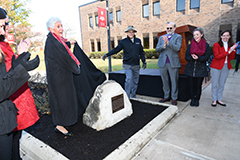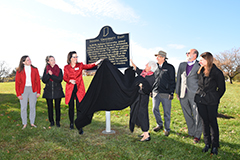IU East dedicates IU Bicentennial, State Historical Markers
Indiana University East unveiled an Indiana University Bicentennial Marker and a State Historical Marker today (November 5) during a dedication ceremony.
The markers are located in front of Whitewater Hall, IU East’s first building on campus.

IU East Chancellor Kathy Cruz-Uribe unveils the IU Bicentennial Marker during the dedication ceremony held November 5 in front of Whitewater Hall.
The dedication ceremony was led by IU East Chancellor Kathy Cruz-Uribe and platform guests Melissa Vance, CEO of the Wayne County Area Chamber of Commerce; Casey Pfeiffer, Historical Marker program director for the Indiana Historical Bureau Division of the Indiana State Library; James Capshew, University Historian for Indiana University; TJ Rivard, associate vice chancellor for Academic Affairs at IU East; Elizabeth George, IU East student and Student Government Association vice president; and Angie Dickman, vice president at Reid Health and chair of the IU East Board of Advisors.
The dedication ceremony is one of many events this week during IU East’s 2019 Homecoming: Pack to the Future.
The IU Bicentennial Marker is located in the John W. and Patricia Ryan Rose Walkway in front of Whitewater Hall. John William Ryan (1929–2011) served as the 14th president of Indiana University from 1971-1987, during the time IU East was established as a regional campus.
IU is celebrating its Bicentennial this year. As a part of the celebrations, IU is adding historical markers at campuses across the state to commemorate significant people, places, events and organizations that have had an impact on IU, the state, the nation and the world. The State Historical Marker is located at the entrance to the right of the walkway.
Chancellor Cruz-Uribe said the markers signify the commitment and service the campus has provided to the region, especially as IU East prepares to celebrate its 50th anniversary beginning July 1, 2020.
“All of Indiana University’s regional campuses are proud to be part of such a fine institution with a long and distinguished history,” Cruz-Uribe said. “It is exciting to be standing here, on the brink of IU’s third century of outstanding scholarship and service to the state of Indiana.”

IU East also dedicated a State Historical Marker in front of Whitewater Hall on November 5. The State Historical Marker is the 13th placed in Wayne County. Chancellor Cruz-Uribe and Melissa Vance unveil the State Historic Marker with (from left to right) Angie Dickman, Elizabeth George, James Capshew, TJ Rivard and Casey Pfeiffer.
On July 1, 1971, the IU Board of Trustees established Indiana University East. A group of community leaders raised funds by area citizens and the trustees purchased 225 acres of land in Richmond near the junction of U.S. 27 and Interstate 70. Construction of the first building, Whitewater Hall, was completed in 1974 and dedicated in January 1975.
“These markers will be landmarks on the IU East campus that will inspire future generations of students and scholars,” Cruz-Uribe said. “I hope that all who pass by, or who pause to reflect here, will remember the origins of our campus and particularly our close ties to the community, which we are proud to serve in so many ways through our teaching, scholarly activities, and service.”
Rivard said the markers represent the history and community connections, but also over 10,800 alumni.
“First, these markers honor the work of the faculty, staff, and community in establishing an institution of higher learning in Richmond, Indiana,” Rivard said. “Second, they are also a reminder of what has made IU East relevant: the constructive relationships, conversations, and collaborative partnerships which allowed — and continue to allow — the educational mission to flourish. Finally, and more importantly, they are a tribute to the accomplishments of the students who have passed through the university and now contribute in important ways to their communities as a result.”
Capshew said he was happy to attend today’s event to dedicate the markers.
“IU East has a great sense of history,” Capshew said. “These markers commemorate and document the large role that Indiana University has played to provide higher education statewide. It is important to commemorate the buildings and places where students have learned, socialized, and connected with others. The markers are a way to relate the past with the present.”
The State Historical Marker is the 13th marker installed in Wayne County.
The state marker examines IU East’s establishment and the growth of the campus over the years. This is one of a series of markers dedicated to commemorate IU’s regional campuses in 2019 and 2020.
Pfeiffer said the State Historical Markers date back to 1946 and include over 670 markers across the state. She said historical markers provide an opportunity to return stories to the historical landscape in which they belong.
“By doing so, we’re able to examine, commemorate, and reflect on the wide variety of topics that have had a significant impact in shaping the stat,” Pfeiffer said. “This new marker for IU East allows us to share the history of this campus and the larger history of IU’s regional campuses. This is actually the first of several markers that will be commemorated this year and in 2020 for IU’s regional campuses and we look forward to being part of those programs as well.”
Today’s ceremony is available to watch on Facebook at iue.edu/Facebook.
About the IU Bicentennial Marker
The IU Bicentennial Marker is modeled after the State of Indiana’s historical marker program and many successful municipal programs, the Indiana University Historical Marker Program notes significant people, places, events, and organizations that have had an extraordinary impact on the university, state, nation, and world. The markers are visually appealing and are installed on campus and at off-campus heritage sites where appropriate.
The IU Bicentennial Marker reads:
In 1971, the Trustees of Indiana University, with significant financial assistance from local residents, purchased land for a new campus in Richmond.[1] Breaking ground in 1972, the main building of Indiana University East was dedicated by IU President John Ryan in 1975.[2] This building, similar in function and style to first buildings on other regional campuses, served as a comprehensive academic center. It provided classrooms, laboratories, an auditorium, computer facilities, a library, a student center, and faculty and staff offices for the new campus.[3] In 1992, upon the construction of Hayes Hall, the campus’ second building, it was christened Whitewater Hall, in honor of the east fork of the Whitewater River running through Richmond.[4] Remaining a vital center on an expanded campus, Whitewater Hall embodies the confluence of educational aspirations in the local community with the statewide presence of Indiana University.
For more information on the IU Bicentennial, visit 200.iu.edu.
About the State Historical Marker
State historical markers commemorate significant individuals, organizations, places, and events in Indiana history.
These markers help communities throughout the state promote, preserve, and present their history for the education and enjoyment of residents and tourists of all ages. For over 100 years, the Indiana Historical Bureau has been marking Indiana history. Since 1946, the marker format has been the large roadside marker, which has the familiar dark blue background with gold lettering and the outline of the state of Indiana at the top. Over 670 of these markers have been installed over the years.
The IU East marker is the 13th state historical marker installed in Wayne County. For a listing of other markers in the county, visit in.gov/history/markers/3819.htm#wayne.
The state marker reads:
In 1946, Indiana University joined Earlham College to form an extension center in Richmond to meet the region’s educational needs. The center offered the first two years of college credit through evening classes held at the Earlham campus. In 1967, Purdue University and Ball State University partnered with the center to expand vocational and technical courses. By 1970, community members raised funds for a new campus and IU began assuming administrative responsibilities. In 1971, the center became Indiana University East, the sixth regional campus of IU. Construction of the first building, later Whitewater Hall, was completed in 1974. The new campus was dedicated in 1975 and first bachelor’s degree awarded in 1977.
For more information about the Indiana Historical Marker Program and other resources about Indiana, visit the Indiana Historical Bureau’s website at IN.gov/history.

